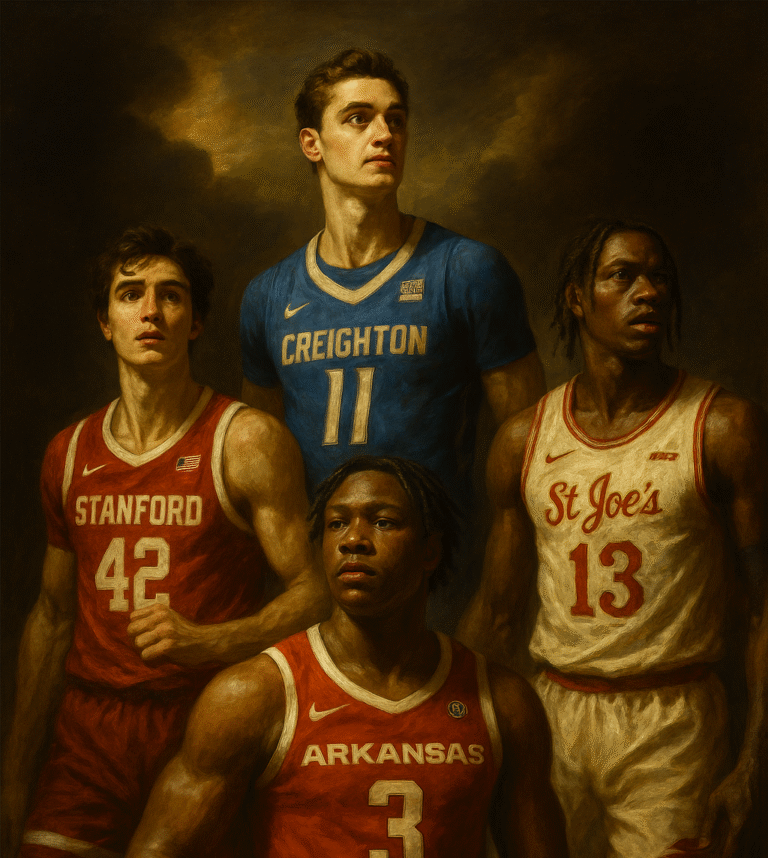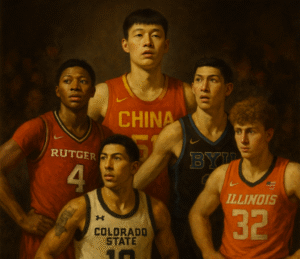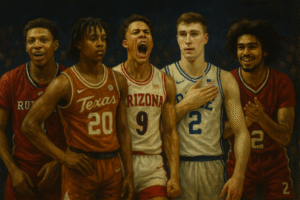2025 NBA Draft Tiers: Day 2 Guide

The second round of the NBA Draft often gets overshadowed by the lottery and big trades, but this is where savvy front offices find value. The top is loaded with high-floor role players, project bigs, and overlooked international prospects who can outperform their draft slot. Don’t be surprised if multiple long-term rotation players come from this group, especially as teams swing on fit, context, and scheme versatility.
This isn’t a comprehensive breakdown of every second-round candidate, but these are the names worth circling. Some are fringe first-rounders who slid due to age or lack of flash. Others are raw bets on upside. Fit matters more here than ever, and for the right team, any of these players could become a steal.
Holdovers From Round 1
This group includes prospects who consistently showed up in late first-round mocks but now slip into the 30s or 40s. They offer translatable skills, NBA-ready frames, and clear roles—but lacked enough upside or team buzz to solidify a Day 1 selection. Don’t be surprised if several end up outperforming players picked 10–15 slots ahead.
Rasheer Fleming
Fleming brings toughness, rebounding, and defensive versatility as a modern combo forward. He’s not a go-to scorer, but he does the dirty work and makes timely plays. An easy fit in most systems that value toughness and team defense. Potential as a stretch big.
Adou Thiero
Thiero is a rangy athlete who covers ground defensively and finishes through contact. The offensive game is still raw, especially the handle and shot, but his defensive ceiling is real. Projects as a role-playing wing that earns minutes with effort.
Maxime Raynaud
The Stanford big is mobile, smart, and reliable with both touch and timing. He won’t wow anyone with athleticism, but he plays within himself and doesn’t make mistakes. A high-floor option for teams needing backup center depth.
Ryan Kalbranker
Kalbranker is a true interior big with elite rim protection instincts and soft touch around the basket. He can stretch the floor on short pick-and-pops and punish mismatches inside, giving him value as a secondary scorer. The big concern is mobility—he’s slow-footed in space and struggles in switch-heavy schemes. Think of him as a poor man’s Donovan Clingan: effective in drop coverage, but matchup-dependent.
Chaz Lanier
One of the best pure shooters in the class, Lanier has the gravity to warp defenses off the bench. He’s strong, decisive, and plays with confidence, though the defense is still a question. Projects as a bench scorer who can close some games if the shot stays elite.
Tyrese Proctor
A year ago he was a projected lottery pick—now he’s trying to rebuild value. Proctor still has a smooth handle, good vision, and defensive tools, but the shooting and consistency haven’t come along. A change of scenery could reignite the upside.
International Players Expected to Go Early
These international prospects didn’t quite rise into the first round, but they remain high-priority targets in the early second. They’re tools-y, often young, and offer something different from the average college role player. Expect teams with multiple picks—or deep scouting departments—to swing big here.
Noah Pende
At 6’8 with guard skills, Pende’s intrigue lies in his movement and flashes of playmaking. The shooting needs work, and he often floats through games, but his size and versatility keep him draftable. A swing-for-upside play who could thrive in a developmental system.
Bogoljub Marković
Marković is one of the most efficient scorers in the international class, with a soft touch around the rim and growing confidence from the perimeter. He flashes real passing chops for a big and can function as a short-roll playmaker or high-post hub. Defensively, he’ll drift and miss rotations, but if the motor and awareness click, there’s legitimate upside. Could be a late-round steal if the shot and defense come together.
Two-Way Players
Probable two-way contract candidates with a pathway to becoming full-time NBA players. Some are fifth-year seniors with defined skills, others are underdeveloped athletes in need of structure. These aren’t just end-of-roster guys—several will stick, and a few will break out if they land in the right situation.
Grant Nelson
The tools are there—athleticism, length, flashes of shooting—but Nelson has struggled to translate them against better competition at Alabama. He’ll get looks late based on his motor and physical tools. A likely two-way contract candidate with potential to carve out a niche.
Eric Dixon
A strong, floor-spacing big who shot over 35% from three at Villanova, Dixon offers a defined offensive skill set. He’s undersized for a true 5 and limited defensively, but his shooting and feel give him pick-and-pop appeal. Could find a niche as a second-unit stretch big if the defense holds up.
Jamir Watkins
A versatile wing with size and creation flashes, Watkins defends well across positions and plays with real energy. The shot is streaky, and the decision-making needs refinement, but his tools and motor will earn him looks. If he can become a reliable catch-and-shoot option, he has real rotation upside.
Tamar Bates
Bates is a smooth-scoring combo guard who thrived in a lower-usage role at Mizzou after an inconsistent stint at Indiana. He’s a tough shot-maker with flashes of pull-up shooting, but doesn’t offer much as a passer. If the defense and shooting stay consistent, he has microwave scorer potential off the bench.
Dink Pate
Still one of the youngest players in the class, Pate is a long-term bet on size and playmaking. At 6’7, he has intriguing vision and ball-handling for a wing, but the jumper and decision-making are still developing.
Ryan Nembhard
A steady-handed point guard with elite feel and floor vision, Nembhard is one of the best game managers in the class. He lacks size and top-tier athleticism, but he gets to his spots and makes the right reads. Teams looking for a reliable backup point guard will have him high on their second-round boards.
Johni Broome
Broome is a physical interior presence with touch, rebounding instincts, and consistent production at Auburn. He’s not the most mobile big, but he blocks shots and has flashed improved shooting range. Projects as a rotation big in more traditional, drop-heavy schemes.
Hunter Sallis
A long, explosive combo guard who finally broke out offensively at Wake Forest after transferring from Gonzaga. Sallis thrives in transition, defends both guard spots, and has improved his jumper year-over-year. He’s trending upward and could return first-round value if the shooting sticks.
Sion James
James is a tough, defensive-minded guard with a strong frame and a low-maintenance offensive game. He won’t create much, but he moves the ball, plays with purpose, and guards hard. A second-unit guard who could stick as a specialist.
Amari Williams
A physical, rim-protecting big with a defensive presence that pops on tape. Williams moves well for his size, contests shots without fouling, and plays with energy. Offensively, he’s raw—but his defense will earn him a camp invite, if not a guaranteed contract.
John Tonje
Tonje is a confident shooter with size who can fill it up quickly when he gets hot. He’s a bit one-dimensional and doesn’t add much on the defensive end, but his floor spacing could earn him a look on a two-way deal. Ideal flyer for teams looking to boost bench shooting.
Koby Brea
An elite catch-and-shoot wing who hit over 40% from three multiple seasons at Dayton, Brea plays his role with discipline. He’s limited defensively and doesn’t create, but he’s one of the best off-ball snipers in the draft. A specialist who could thrive in spacing-heavy systems.
Kam Jones
Jones is a shifty lefty guard with deep range and confidence as a scorer. He can create off the dribble and hit tough shots, though he’s undersized and streaky. Best suited for a scoring role off the bench where he’s free to hunt buckets.
Kobe Sanders
Sanders is a long, fluid combo guard with defensive instincts and secondary playmaking upside. He’s not a consistent shooter yet, but his frame and versatility give him an NBA physical profile. A strong candidate for a developmental path on a two-way.
International Players With Wide Ranges
These international names could land anywhere from the 30s to the undrafted pool depending on team preference, draft-night trades, and overall board movement. They’re mostly long-term investments, often with clear strengths and glaring holes. Smart teams won’t ignore the upside here—even if it comes with patience.
Rocco Zikarsky
One of the tallest players in the class, Zikarsky blocks shots with ease and has shown pick-and-pop flashes. He’s still a project—slow feet, mechanical shot—but the outline of a modern 5 is there. Long-term investment for teams with patience.
Mohamed Diawara
Diawara is a high-energy forward who plays with motor and physicality on the defensive end. He lacks shooting range and is still refining his offensive game, but his rebounding and switchability make him interesting. Could thrive in a role similar to Rondae Hollis-Jefferson if the feel develops.
Saliou Niang
An intriguing young wing with burst and defensive instincts, Niang brings raw upside with flashes of shot-making and perimeter defense. The feel and polish are inconsistent, but he has the athletic foundation teams look to mold. A developmental pick with long-term potential as a 3-and-D wing.
Alex Toohey
Toohey is a 6’8 forward with a strong frame and mature approach, capable of making the right reads and knocking down open shots. He isn’t explosive, but he plays with feel, cuts well, and fits in team contexts. A potential stash or end-of-bench connector with upside as a glue guy.
Related Posts

2025 NBA Draft Breakdown: First Round Recap & Analysis
The 2025 NBA Draft largely validated pre-draft consensus as most of the top selections fell within projected ranges. Teams prioritized two-way versatility, shotmaking, and players with high upside. Still, there were notable deviations that highlighted how individual team context continues to shape draft strategy more than media boards or aggregated mock drafts.

2025 NBA Draft Tiers: Day 1 Guide
This guide is built to give you a snapshot of what to expect on draft night. Each player is slotted within a projected range based on league chatter, team needs, and archetypal value—along with a brief overview of who they are and why their name might be called.
